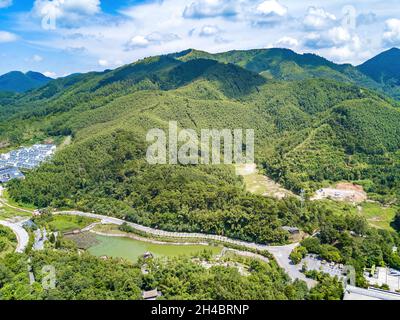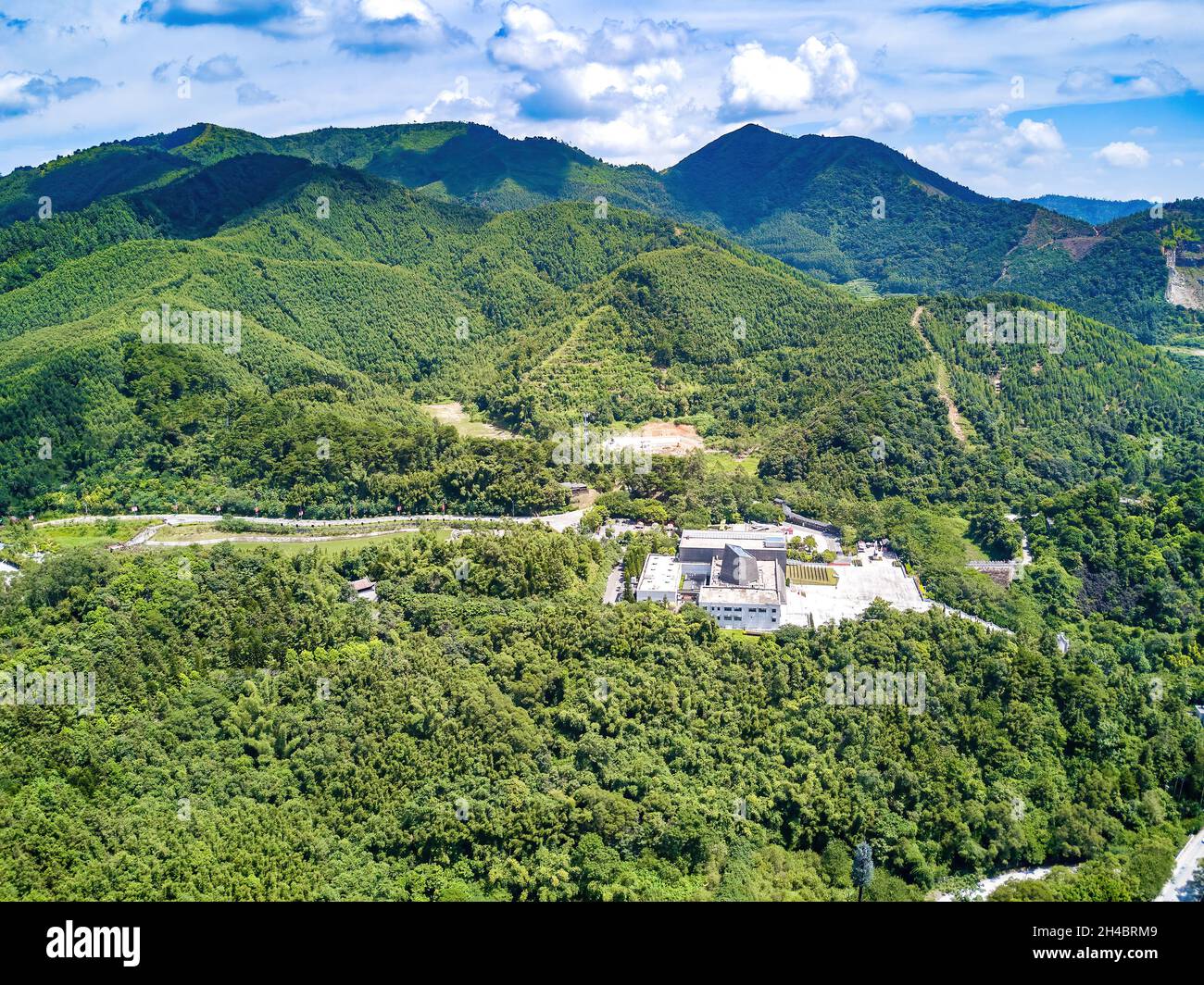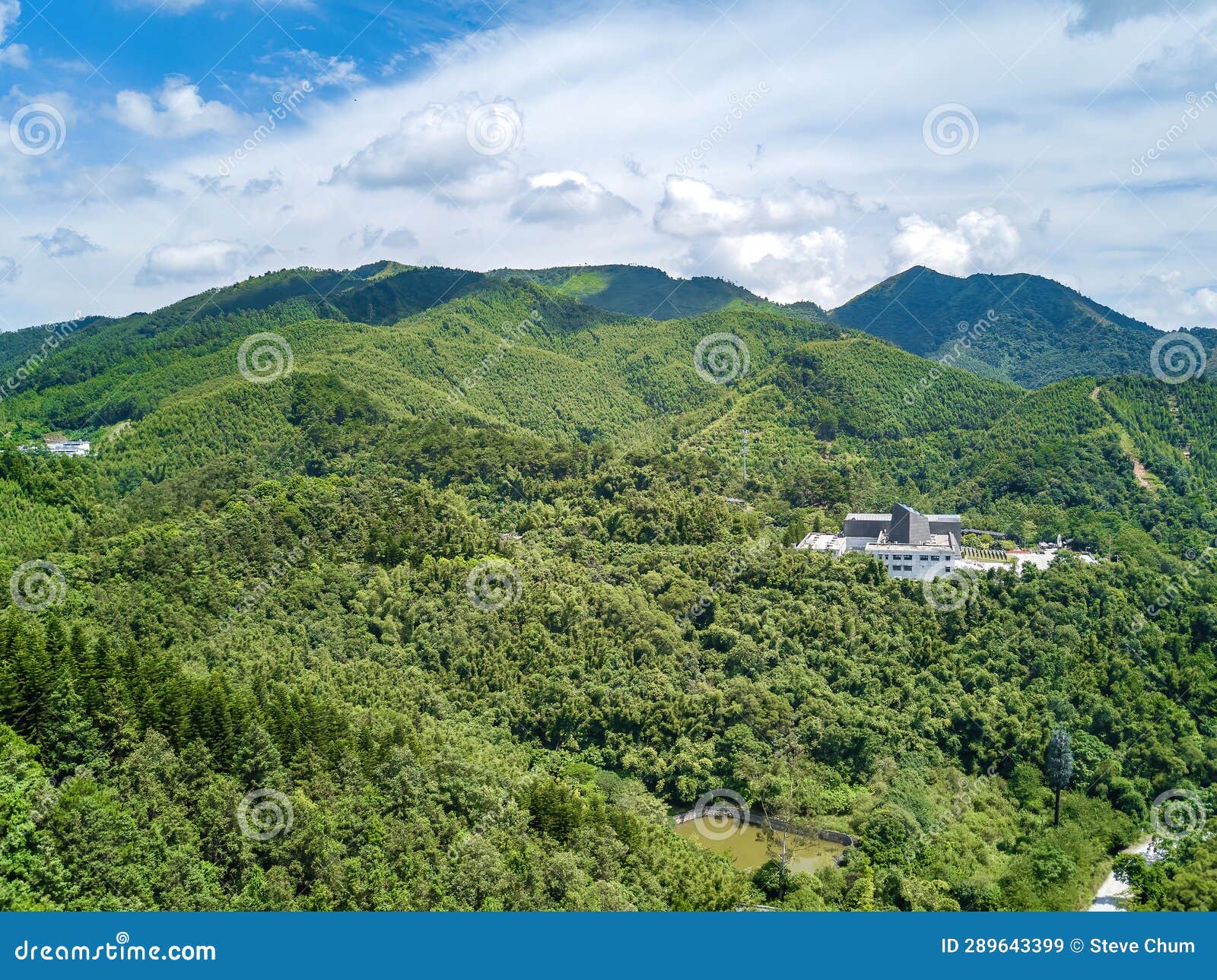Top 5 Activities to Enjoy at Nanning Kunlun Pass

An Essential Guide to Visiting Nanning Kunlun Pass
Nestled just 50 kilometers from the vibrant city of Nanning, Kunlun Pass (南宁昆仑关) beckons travelers with its rich historical tapestry and breathtaking natural scenery. Often celebrated as one of China’s most significant military passes, this ancient site is steeped in legends, having witnessed countless battles throughout its storied past. From the era of the Han Dynasty, when it was first constructed by the valiant General Ma Yuan, to the strategic confrontations of the Tang and Song dynasties, Kunlun Pass has long served as a critical point of defense and a symbol of resilience.
As you ascend the stone steps that lead through lush green forests, the echoes of history resonate around you, accompanied by inscriptions from renowned figures that add a cultural touch to the journey. The centerpiece of your visit will likely be the Kunlun Pass Battle Museum, where more than 1,000 artifacts narrate the tales of bravery from the Anti-Japanese War and beyond. Here, the V-shaped marble structure stands as a testament to victory, while the memorials pay homage to the valiant soldiers who fought for their homeland.
Visiting Kunlun Pass is not merely an exploration of a tourist attraction; it’s an immersive experience that connects you to the heart of China’s historical narrative. Whether you are a history enthusiast, a nature lover, or simply seeking a unique adventure, this scenic area offers an unforgettable glimpse into the past, set against a backdrop of stunning landscapes. Prepare to be captivated by the beauty and significance of Kunlun Pass, where every step tells a story waiting to be discovered.
In This Guide
- An Essential Guide to Visiting Nanning Kunlun Pass
- The Rich History and Legends of Nanning Kunlun Pass
- Main Highlights: What You Absolutely Can’t Miss
- Planning Your Visit: A Practical Guide
- Tickets: Prices, Booking, and Tips
- How to Get There: A Complete Transportation Guide
- Local Cuisine and Accommodation Nearby
- Frequently Asked Questions
- Final Thoughts on Your Trip
The Rich History and Legends of Nanning Kunlun Pass
Nestled in the rugged terrain of Binyang County, approximately 50 kilometers from the city of Nanning, Kunlun Pass (南宁昆仑关) boasts a rich tapestry of history and legend that draws visitors eager to explore its storied past. Known as one of the ten most famous passes in China, its strategic location has made it a significant military stronghold for over a thousand years.
The origins of Kunlun Pass can be traced back to the Han Dynasty, with the legendary general Ma Yuan credited with its construction. However, its history truly began to unfold during the Tang Dynasty when, in 819 AD, Pei Xingli raised the first stone structures to fortify the pass. This early fortification was just the beginning of a lengthy saga marked by military intrigue and conflict.
Throughout the centuries, Kunlun Pass has witnessed nine major battles, each contributing to its formidable reputation. Among these, the most notable is the Battle of Kunlun Pass during the Anti-Japanese War. This tragic confrontation not only underscores the pass’s military significance but also serves as a poignant reminder of the sacrifices made during tumultuous times. In honor of these brave soldiers, a cemetery was established on the mountainside, featuring a striking archway inscribed with the names of notable military figures and a memorial that pays tribute to the lives lost.
The architecture of Kunlun Pass is itself a testament to its storied past. Over the years, it has evolved through various dynasties, with enhancements such as the guard tower constructed in 1035 during the Northern Song Dynasty. This tower, along with the surrounding fortifications, stands as a symbol of resilience and strength against invading forces.
Today, visitors to Kunlun Pass can immerse themselves in its historical ambiance by ascending the stone steps that wind through lush forests, adorned with inscriptions from renowned figures. The tranquility of the surroundings contrasts sharply with the fierce battles that once raged here, offering a unique opportunity to reflect on the passage of time.
At the Kunlun Pass Battle Museum, one can delve deeper into the pass’s military history. The museum showcases a vast collection of artifacts, including weapons and equipment used in ancient conflicts. Its signature “V-shaped” structure, crafted from 86 tons of marble, symbolizes victory and resilience, while an obelisk array honors the 3,400 soldiers who perished in the most significant battles.
As you explore Kunlun Pass, you will not only traverse a landscape of breathtaking natural beauty but also walk in the footsteps of history. Each stone and inscription tells a story, echoing the valor of those who fought to protect this vital passage. For travelers seeking a glimpse into China’s rich historical narrative, Kunlun Pass invites you to discover its legends and the enduring spirit of those who shaped its destiny.

Nanning Kunlun Pass.
Main Highlights: What You Absolutely Can’t Miss
Nestled in the scenic Kunlun Town, about 50 kilometers from the vibrant city of Nanning, Kunlun Pass (南宁昆仑关) is a treasure trove of history, natural beauty, and cultural significance that beckons international travelers. Here are the unmissable highlights that will make your visit unforgettable:
Historical Significance
Step back in time as you explore the legendary origins of Kunlun Pass, built by the famed General Ma Yuan during the Han Dynasty. This ancient pass has witnessed numerous battles, including significant conflicts during the Tang Dynasty and the Anti-Japanese War. The rich tapestry of history is palpable, making it a must-visit for history enthusiasts.
Scenic Stone Steps
The journey to the top of Kunlun Pass is an adventure in itself. Ascend the winding stone steps, surrounded by lush green forests and the echoes of history. The serene environment invites you to take your time, breathe in the fresh air, and enjoy the tranquil beauty that envelops you.
Kunlun Pass Battle Museum
Don’t miss the Kunlun Pass Battle Museum, a unique institution dedicated to the region’s military history. Spanning over 3,500 square meters, this museum showcases a remarkable collection of more than 1,000 relics, including weapons and equipment used in ancient battles. The striking “V-shaped” structure made of 86 tons of marble symbolizes victory and stands as a testament to the sacrifices made during the wars.
Memorials and Inscriptions
As you wander through the pass, keep an eye out for the various memorials and inscriptions. The Soldiers Cemetery, located on the mountain, features a granite staircase leading to a beautifully crafted archway, inscribed by notable figures such as Du Yuming and Li Zongren. These inscriptions tell stories of bravery and honor, allowing visitors to connect with the past on a personal level.
Natural Beauty
Surrounding the historical sites is stunning natural scenery. The area is rich in biodiversity, with forests that offer a peaceful retreat. The harmonious blend of history and nature creates a unique atmosphere, making it an ideal spot for photography, reflection, and inspiration.
Cultural Experiences
Explore the peaceful archways and serene pathways dotted throughout the pass, where you can find inscriptions from celebrities and scholars. These cultural markers add depth to your visit, revealing the influence of renowned figures on the region’s history and development.
Accessibility and Visitor Information
Reaching Kunlun Pass is convenient, with various transportation options available from Nanning. Whether you choose to drive or join a guided tour, the journey promises to be as enriching as the destination itself.
Best Time to Visit
While Kunlun Pass can be visited year-round, the best times are during spring and autumn when the weather is mild, and the scenery is at its most vibrant. This ensures a comfortable experience as you explore the outdoor attractions.
In summary, a visit to Kunlun Pass offers a unique blend of history, culture, and natural beauty that you simply cannot miss when traveling around Nanning. Whether you’re a history buff, nature lover, or simply seeking a tranquil escape, Kunlun Pass has something special to offer every traveler.

Nanning Kunlun Pass.
Planning Your Visit: A Practical Guide
Your Essential Guide to Visiting Nanning Kunlun Pass
Nanning Kunlun Pass, steeped in history and natural beauty, is a must-visit destination for travelers looking to experience a unique slice of China. Nestled in Kunlun Town, Binyang County, approximately 50 kilometers from Nanning, this scenic area offers a rich tapestry of historical significance and stunning landscapes. Here’s how to make the most of your visit.
Getting There
Transportation Options:
– By Car: The most convenient way to reach Kunlun Pass is by car. If you’re driving from Nanning, take the G75 highway, which will lead you directly to the pass. The journey typically takes about an hour.
– Public Transport: If you prefer public transport, local buses run from Nanning to Binyang County. From Binyang, you can take a taxi or a local minibus to the entrance of Kunlun Pass.
Best Time to Visit
The ideal time to explore Kunlun Pass is during the spring (March to May) and autumn (September to November) months when the weather is mild and the scenery is at its most vibrant. Summer can be hot and humid, while winter temperatures can drop significantly.
What to Expect
Historical Significance:
Kunlun Pass is not just a beautiful site; it is steeped in history. Established during the Han Dynasty and fortified in subsequent dynasties, it has been the backdrop for many significant battles, including the notable Kunlun Pass Battle during the Anti-Japanese War. The site is recognized as one of China’s top ten famous passes.
Main Attractions:
– Stone Steps & Inscriptions: Begin your journey by climbing the scenic stone steps leading up the pass, surrounded by lush greenery and famous inscriptions from historical figures.
– Kunlun Pass Battle Museum: This museum is an essential stop for history buffs. It houses over 1,000 relics from ancient battles and features a striking “V-shaped” structure made of 86 tons of marble, symbolizing victory. The museum also honors the soldiers who lost their lives in the battles here.
– Soldiers Cemetery: A solemn yet significant site, the cemetery is accessible via 331 granite steps and features inscriptions by renowned military figures.
– Peaceful Archways: Scattered throughout the area, these beautiful archways provide serene spots to reflect on the history and beauty surrounding you.
Tips for Your Visit
- Wear Comfortable Footwear: The climb can be steep and involves navigating stone steps, so sturdy shoes are essential.
- Stay Hydrated: Bring water, especially if you’re visiting during the warmer months.
- Plan Your Time: Allocate at least half a day to fully explore Kunlun Pass, including time to visit the museum and walk through the cemetery and surrounding areas.
- Photography: Don’t forget your camera! The views from the summit and the historical structures are breathtaking and make for perfect photo opportunities.
Nearby Attractions
If you have time, consider exploring other attractions in the Nanning area:
– Nanning Flower World: A beautiful park featuring diverse flora and themed gardens.
– Yongjiang River: Perfect for a leisurely stroll or boat ride, offering picturesque views.
– Mingshi Scenic Area: Known as “Little Guilin,” this area features stunning karst landscapes and is great for outdoor activities.
Dining Options
While at Kunlun Pass, you may want to enjoy local cuisine. Look for nearby restaurants or street food stalls offering traditional Guangxi dishes such as Guilin rice noodles and stir-fried river shrimp.
Final Thoughts
A visit to Nanning Kunlun Pass is not just a journey through beautiful landscapes but also a step back in time to witness the rich history of the region. Whether you’re a history enthusiast, a nature lover, or simply seeking a unique travel experience, Kunlun Pass promises to leave you inspired and enriched. Plan your visit today and prepare for an unforgettable adventure!

Nanning Kunlun Pass.
Tickets: Prices, Booking, and Tips
When planning your visit to Kunlun Pass, understanding ticket prices, booking options, and helpful tips will enhance your experience at this historic site.
Ticket Prices
The entrance fee for Kunlun Pass is approximately 60 CNY (around 9 USD) per person. This ticket grants you access to the scenic areas, including the stone paths, the Kunlun Pass Battle Museum, and the Soldiers Cemetery, where you can immerse yourself in the rich history and natural beauty of the location.
Booking Options
You have a few options for booking your tickets to Kunlun Pass:
-
On-site Purchase: Tickets can be purchased directly at the entrance. Arriving early in the day is advisable to avoid long queues, especially during weekends and holidays.
-
Online Booking: To save time, consider booking your tickets online through various travel platforms that offer pre-purchased tickets. This option often allows for discounts or package deals.
-
Guided Tours: Many travel agencies offer guided tours that include transportation, entrance fees, and a knowledgeable guide. This is an excellent option if you prefer a structured itinerary and insights into the historical significance of the site.
Tips for Visiting
-
Best Time to Visit: The ideal time to visit Kunlun Pass is during the spring (April to June) and autumn (September to November) months when the weather is pleasant, and the surrounding scenery is at its most vibrant.
-
Transportation: Kunlun Pass is located about 50 kilometers from Nanning. Renting a car or hiring a private driver is recommended for convenience, as public transportation options may be limited.
-
What to Bring: Wear comfortable shoes suitable for climbing, as the main path involves several stone steps. Bring along water, sunscreen, and a camera to capture the stunning views.
-
Plan Your Visit: Allocate at least half a day to fully explore Kunlun Pass, including time spent at the museum and the Soldiers Cemetery. Make sure to take in the peaceful surroundings and historical inscriptions scattered throughout the area.
By keeping these details in mind, you’ll be well-prepared to enjoy your visit to Kunlun Pass, a gem of history nestled in the lush landscapes of Guangxi.
How to Get There: A Complete Transportation Guide
To experience the historic and scenic Kunlun Pass, located approximately 50 kilometers from Nanning, you’ll find a variety of transportation options that cater to international travelers. Here’s how you can make your way to this notable destination with ease.
Getting to Nanning
By Air
Nanning Wuxu International Airport (NNG) serves as the primary gateway for international travelers. Direct flights connect Nanning to several Southeast Asian cities, including Singapore, Kuala Lumpur, and Jakarta. Upon arrival, you can conveniently catch a taxi or use a ride-hailing app to reach the city center.
By Train
Nanning is well-connected by train, with high-speed rail links to major cities across China such as Guangzhou, Shenzhen, and Guilin. The Nanning Railway Station is located in the city center, making it easy to transfer to local transportation upon your arrival.
Reaching Kunlun Pass from Nanning
Once you’re in Nanning, here are a few ways to get to Kunlun Pass:
By Taxi or Ride-Hailing Service
The most straightforward method is to take a taxi or use a ride-hailing app like Didi. The journey to Kunlun Pass typically takes about 1.5 to 2 hours, depending on traffic conditions. Ensure that you have the destination written in Chinese (昆仑关) to show the driver.
By Bus
For a more budget-friendly option, consider taking a bus from Nanning to Binyang County, which is the nearest town to Kunlun Pass. Buses leave from the Nanning Bus Station (南宁汽车站) and the trip usually takes around 1.5 to 2 hours. Once you arrive in Binyang, you can hire a local taxi or use a ride-hailing app to reach the pass, which is roughly 15 kilometers away.
By Private Car or Tour Package
If you prefer a more personalized experience, consider booking a private car or joining a tour package that includes transportation to Kunlun Pass. This option not only offers convenience but also allows you to enjoy the scenic countryside along the way.
Tips for Traveling to Kunlun Pass
- Check Public Transport Schedules: If you opt for the bus, make sure to check the latest schedules and availability, as they may vary.
- Language Barrier: While most taxi drivers in Nanning understand basic English, having your destination in Chinese will help avoid any confusion.
- Plan Your Return: While exploring Kunlun Pass, be mindful of your return transportation, especially if you’re relying on public buses or have scheduled tours.
Conclusion
Whether you’re drawn to the rich history of Kunlun Pass or the stunning natural scenery that surrounds it, reaching this remarkable site from Nanning is both accessible and enjoyable. With options ranging from taxis to buses, you can choose the transportation method that best fits your travel style and budget. Happy travels!

Nanning Kunlun Pass.
Local Cuisine and Accommodation Nearby
When visiting Kunlun Pass, you’ll not only be captivated by its rich history and stunning landscapes but also delighted by the local cuisine and accommodation options that enhance your travel experience. Here’s a guide to savoring the flavors of the region and finding a cozy spot to rest your head after a day of exploration.
Local Cuisine
The area surrounding Kunlun Pass is known for its delectable local dishes that reflect the diverse cultural influences of the Guangxi region. Here are some must-try culinary delights:
-
Luosifen (螺蛳粉): This iconic Guilin rice noodle soup is a favorite among locals and visitors alike. It features rice noodles served in a flavorful broth made from river snails, topped with pickled bamboo shoots, peanuts, and fresh herbs. The unique blend of spicy and sour flavors is a must for adventurous eaters.
-
Bamboo Rice (竹筒饭): A traditional dish where glutinous rice is cooked inside bamboo tubes, infusing it with a subtle flavor. Often served with various fillings, including meats and vegetables, this dish is both aromatic and visually appealing.
-
Grilled Fish (烤鱼): The region’s rivers provide an abundance of fresh fish, often grilled over an open flame and seasoned with local spices. It’s a simple yet satisfying meal enjoyed in many local eateries.
-
Pineapple Bun (菠萝包): For dessert, try this sweet, soft bun topped with a crunchy, sugary crust that resembles a pineapple’s texture. It’s a popular snack that pairs well with tea or coffee.
-
Zhuang Cuisine: Don’t miss the chance to sample dishes from the Zhuang ethnic group, such as cattle and goat meat dishes, often marinated in local herbs and spices, reflecting the agricultural richness of the area.
Accommodation Nearby
After indulging in the local flavors, you’ll find a range of accommodation options near Kunlun Pass that cater to various budgets and preferences:
-
Kunlun Pass Hotel (昆仑关酒店): Located conveniently close to the pass, this hotel offers comfortable rooms with modern amenities. It’s an ideal base for exploring the area, featuring a restaurant that serves local cuisine, making it easy to enjoy meals without venturing far.
-
Binyang County Guesthouse (宾阳县招待所): For travelers on a budget, this guesthouse provides a cozy atmosphere and basic amenities. The staff are friendly and can offer insights into the local area and recommendations for dining.
-
Mingshi Garden Hotel (明仕园酒店): Situated in the nearby Mingshi Scenic Area, this hotel boasts beautiful views of the karst landscape and offers a peaceful retreat after a day of hiking. The on-site restaurant serves authentic Guangxi dishes, ensuring you continue to enjoy local flavors during your stay.
-
Homestays in Kunlun Town: For a more authentic experience, consider staying in a local homestay. This option allows you to immerse yourself in the culture and hospitality of the region, often with home-cooked meals included.
Conclusion
Exploring Kunlun Pass not only offers a glimpse into China’s rich history but also an opportunity to indulge in the vibrant local cuisine and enjoy comfortable accommodations. Whether you’re savoring a bowl of Luosifen or relaxing in a scenic hotel, your experience will be enriched by the flavors and warmth of Guangxi’s hospitality.

Nanning Kunlun Pass.
Frequently Asked Questions
Frequently Asked Questions about Nanning Kunlun Pass
-
Where is Kunlun Pass located?
Kunlun Pass is situated in Kunlun Town, Binyang County, approximately 50 kilometers from Nanning, the capital of Guangxi Zhuang Autonomous Region. It’s easily accessible by car or organized tour. -
What is the historical significance of Kunlun Pass?
Kunlun Pass has a rich history, dating back over a thousand years. It was established during the Tang Dynasty and has been the site of several significant battles, most notably during the Anti-Japanese War. The area is a testament to ancient military strategies and has been recognized as one of China’s top ten famous passes. -
What attractions can I find at Kunlun Pass?
Visitors can explore the scenic stone steps leading up the pass, enjoy lush green forests, and see inscriptions from historical figures. Additionally, the Kunlun Pass Battle Museum showcases over 1,000 relics from ancient battles, highlighting the region’s military history. -
Is there an entrance fee to visit Kunlun Pass?
Yes, there is an entrance fee to access Kunlun Pass and its attractions, including the museum. The exact cost may vary, so it’s recommended to check current prices in advance or inquire at local tourist information centers. -
What are the best times to visit Kunlun Pass?
The ideal times to visit Kunlun Pass are during spring (March to May) and autumn (September to November) when the weather is mild and the scenery is particularly beautiful. Avoid the summer months when it can be hot and humid. -
How long should I plan to spend at Kunlun Pass?
A visit to Kunlun Pass can typically take about 2 to 3 hours. This allows enough time to explore the main attractions, including the museum and the scenic paths, without feeling rushed. -
Is Kunlun Pass suitable for families with children?
Yes, Kunlun Pass is family-friendly. The site offers a mix of historical exploration and outdoor activities that can be enjoyable for children. However, some areas may require climbing stairs, so parents should consider their children’s comfort with physical activity. -
What transportation options are available to reach Kunlun Pass from Nanning?
The most convenient way to reach Kunlun Pass is by car. You can either drive yourself or arrange for a private transfer or guided tour. Public transportation options are limited, so planning ahead is advisable.
Final Thoughts on Your Trip
As you wrap up your journey to Kunlun Pass, take a moment to reflect on the rich tapestry of history and natural beauty that this remarkable destination offers. From its storied past as a strategic military site to its serene landscapes adorned with lush greenery and ancient inscriptions, Kunlun Pass invites you to connect with both the echoes of history and the tranquility of nature.
The hike along the stone steps, surrounded by the whispers of the forest, serves as a reminder of the resilience and spirit of those who fought bravely in this very place. Exploring the Kunlun Pass Battle Museum and the Soldiers Cemetery deepens your appreciation for the sacrifices made here, allowing you to honor the past while basking in the present’s peace.
Whether you’re savoring the breathtaking views, feeling the energy of the landscape, or discovering the stories etched into the stones, Kunlun Pass is more than just a sightseeing stop—it’s an experience that enriches your understanding of the region’s heritage. As you depart, carry with you the memories of this unique gem in Guangxi, and let them inspire your future travels. Embrace the spirit of adventure that Kunlun Pass embodies, and know that there are countless more stories waiting to be uncovered in the vibrant tapestry of China.